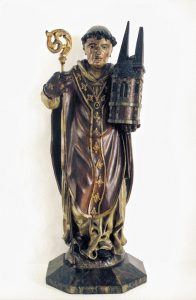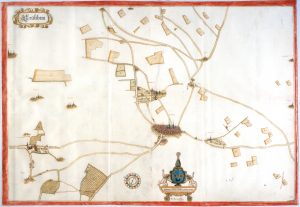A brief historical review
There are few cities from which the origin and history can be traced as well as from Sint-Truiden. The name itself gives away the origin. Sint-Truiden is derived from Trudo, the Frankish aristocrat who built a church and monastery on a small platform in the northern direction, where, on the left, the Cicindria flowed through a deep valley.
The small community became a prosperous abbey that, until the end of the eighteenth century, would witness the ups and downs of the city.
Slowly, a settlement was built near the abbey, but things began to gain momentum in the eleventh century. The pilgrimages towards Sint-Trudo’s grave dit not only bring wealth to the abbey, but also prosperity for the many looking for work outside the agricultural sector.
In that period, in the middle of the eleventh century, abbot Adelardus had his big abbey church built. The tower and remains of the crypt still give a good idea of the hundred-metres-long church. The abbey buidings are silent witnesses of the power and magic of Trudo’s foundation. Adelardus (re)built the Our Lady’s Church and also built the church of Sint-Gangulfus.
Under the reign of the same abbot – the abbot was fellow lord together with the bishop of Metz – Sint-Truiden was girded with a earthen wall, a wooden palisade and fortified entrance gates. The settlement near the abbey had become a city.
In 1129, the first walling was replaced by a fortified wall of stone, that expanded into an impressive belt of gates and towers. After the dismantlement in 1675 and the demolition of the remaining walls, the route remained intact in the city park and the ramparts. A vast underground part of the Brustemporch still exists.
The expansion of the medieval city increased because of the textile industry and the trade to foreign countries. The Grote Markt is the most important witness of local trade : from the church square an increasing space was reserved for the numerous market activities. In the middle, on the separation line of the district of the abbot and that of the prince-bishop (from 1227 onwards it was the prince-bishop of Liège) a hall was built. Later on, in the eighteenth century, over and around the hall tower, the city hall was built. Together with the abbey tower and the Our-Lady’s Church it became the symbol of the city.
The economic and social activities of the city were organised in thirteen trades. Within the land of Liège they fought over the participation of the national government and in their own city they acquired democratic control over the municipal government. As a symbol of this, a platform crowned with an eagle was established.
After the fifteenth century a stagnation occurred, that lasted until the 19th century. What did happen, especially in the eighteenth century, was the embellishment of monastery buildings and civil houses.
After 1830, the vacant monastery buildings became the new housing of congregations that would turn Sint-Truiden into an explicit education- and nursing centre. The market function in an extremely fertile agricultural area remained. The fruit growing, starting from the beginning of the nineteenth century, would give very typical characteristics to this function.
It is remarkable that the first new streets and neighbourhoods only were established in the beginning of the 20th century. But from that moment onwards, changes took place at a very rapid pace. Even the municipal borders that dated back from the middle ages were abolished. This resulted in a merger of communities with their own ancient history. In Zepperen, young Trudo went to visit the bishop. In Brustem, the counts of Loon built a fortress against Sint-Truiden. Duras reminds us of the local counts that often participated in the conflicts around abbey and city.
A medieval city and fourteen historic communities now form a beautiful example of ancient traditions and modern activities in the fertile land of Haspengouw.
(Fernand Duchateau)


